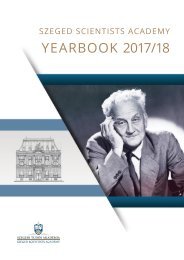SzSA YearBook 2016/17
Create successful ePaper yourself
Turn your PDF publications into a flip-book with our unique Google optimized e-Paper software.
SZENT-GYÖRGYI MENTORS<br />
JÓZSEF MIHÁLY<br />
Developmental Genetics Unit,<br />
Institute of Genetics,<br />
Biological Research Center of the<br />
Hungarian Academy of Sciences<br />
Address: Temesvári krt. 62., H-6726 Szeged, Hungary<br />
E: mihaly.jozsef@brc.mta.hu<br />
T: +36 62/599-687<br />
RESEARCH AREA<br />
The highly dynamic actin cytoskeleton is one of the structurally<br />
and functionally most important cellular constituent.<br />
The actin cytoskeleton is involved in such fundamental<br />
cell biological processes as the maintenance of cell shape,<br />
cell division, intracellular transport and motility. Beyond<br />
that, the actin cytoskeleton is known to play a central role<br />
in the growth and proper navigation of neuronal axons and<br />
dendrites that are necessary to the formation of a functional<br />
nervous system. Our major scientific interest is to gain<br />
a better understanding of the molecular mechanisms of<br />
axonal growth and guidance by uncovering the role of the<br />
growth cone actin cytoskeleton regulatory proteins.<br />
Considering that certain developmental disorders, accidental<br />
injuries and neuro degenerative diseases often result in<br />
severe axonal growth defects or axonal injuries, our studies<br />
are of potential biomedical relevance as they may help to<br />
develop more efficient neuronal regeneration methods.<br />
TECHNIQUES AVAILABLE IN THE LAB<br />
Classical and molecular Drosophila genetics, molecular<br />
biology, cell biology, cytoskeleton analysis, immuno histochemistry,<br />
the basic methods of biochemistry, fluorescent<br />
and confocal microscopy, behavioral tests, live imaging,<br />
digital image analysis.<br />
SELECTED PUBLICATIONS<br />
Gombos, R., Migh, E., Antal, O., Mukherjee, A., Jenny, A.,<br />
Mihály, J. (2015) The Formin DAAM Functions as Molecular<br />
Effector of the Planar Cell Polarity. Pathway during Axonal<br />
Development in Drosophila. J Neurosci 35: 10154-67.<br />
Nelson, KS., Khan, Z., Molnár, I., Mihály, J., Kaschube, M.,<br />
Beitel, GJ. (2012) Drosophila Src regulates anisotropic apical<br />
surface growth to control epithelial tube size. Nat Cell Biol<br />
14: 518-525.<br />
Matusek, T., Gombos, R., Szécsényi, A., Sánchez-Soriano, N.,<br />
Czibula, A., Pataki, C., Gedai, A., Prokop, A., Raskó, I., Mihály,<br />
J. (2008). Formin proteins of the DAAM subfamily play a role<br />
during axon growth. J. Neurosci 28: 13310-13319.<br />
Boutros, M., Mihaly, J., Bouwmeester, T., Mlodzik, M. (2000)<br />
Signaling specificity by Frizzled receptors in Drosophila. Science<br />
288: 1825-1828.<br />
Hogga, I., Mihaly, J., Barges, S., Karch, F. (2001) Replacement<br />
of Fab-7 by the gypsy or scs Insulator Disrupts Long-Distance<br />
Regulatory Interactions in the Abd-B Gene of the Bithorax<br />
Complex. Mol Cell 8: 1145-1151.<br />
Mihaly, J., Mishra, R.K., Karch, F. (1998) A conserved sequence<br />
motif in Polycomb-response elements. Mol Cell 1:<br />
1065-1066.<br />
62












